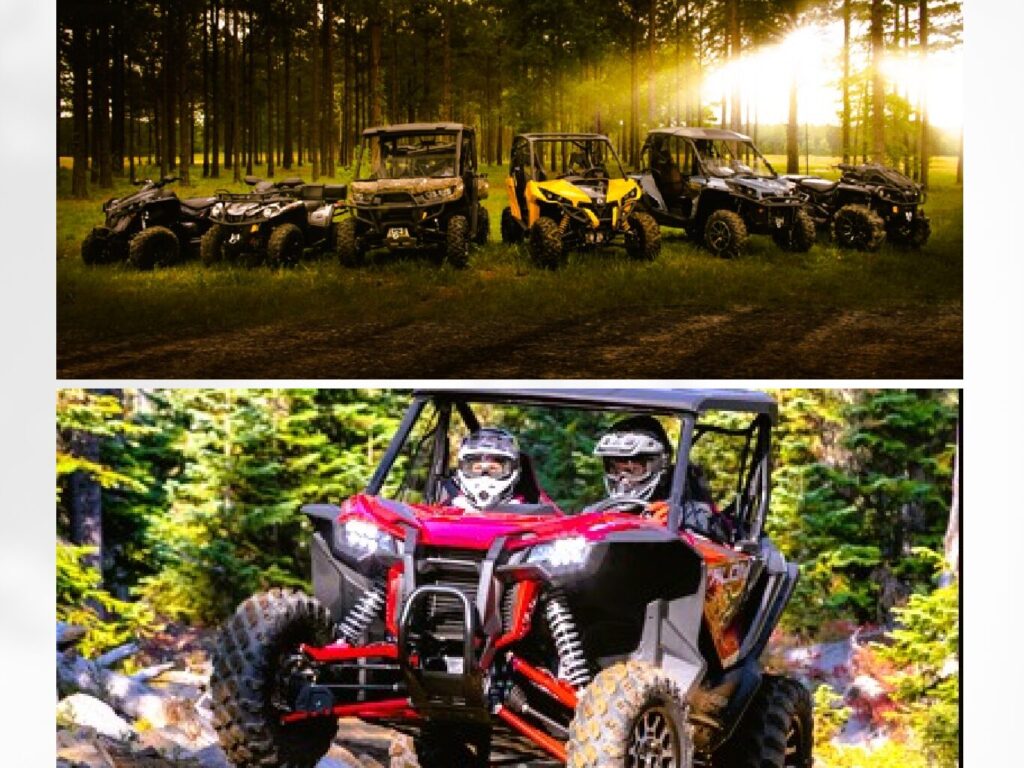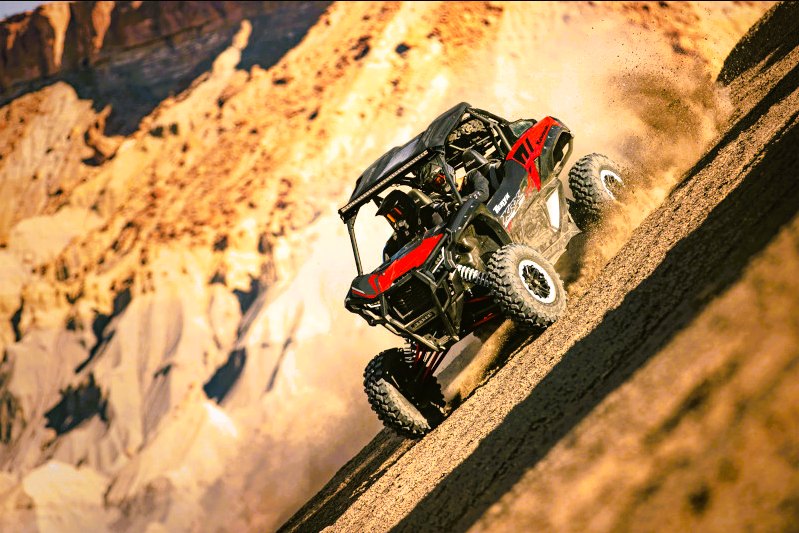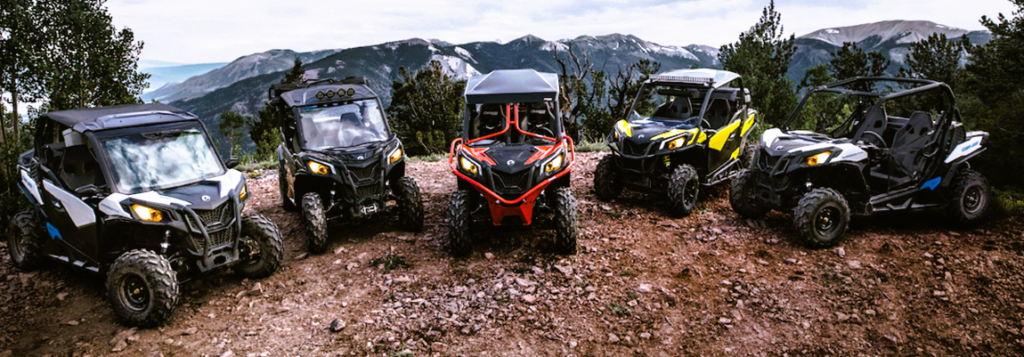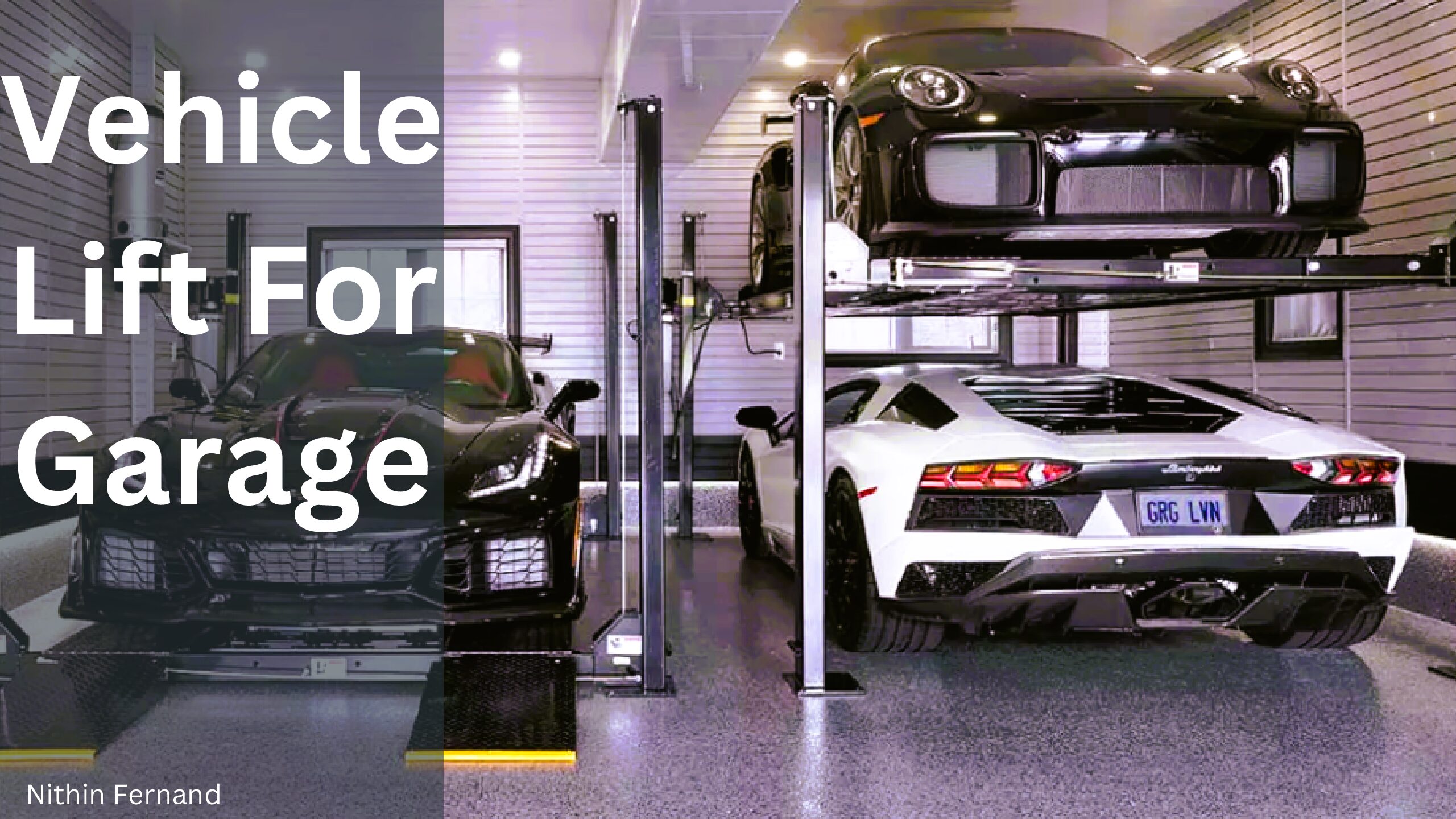Exploring the Thrill and Versatility of Powersports Vehicles 2024
Powersports vehicles, a thrilling category of motorized transport, include a variety of machines designed for both recreational and functional purposes. These vehicles, ranging from rugged all-terrain vehicles (ATVs) to sleek personal watercraft (PWC), offer exhilarating experiences across diverse terrains—be it land, snow, or water.
Their popularity is driven by the sense of adventure and freedom they provide, along with their versatility in different environments. For many, powersports vehicles are more than just a hobby; they’re a lifestyle. Enthusiasts are drawn to the adrenaline rush, the challenge of mastering different terrains, and the unique community that surrounds these powerful machines.

The purpose of this article is to delve into the various types of powersports vehicles available today, highlighting their features, uses, and safety considerations. We’ll explore the current trends in the powersports market, discuss how these vehicles are evolving, and provide insights into their future. Whether you’re an experienced rider or just curious about entering the world of powersports, this article aims to provide valuable information and ignite an interest in this exciting field.
Types of Powersports Vehicles
A. All-Terrain Vehicles (ATVs)
- Definition and Common Uses: ATVs, often referred to as quads, are small, open motorized vehicles with a seat straddled by the operator and handlebars for steering. They are designed for off-road use, making them ideal for a variety of terrains, including mud, sand, and rocky paths. Commonly used for recreation, ATVs also serve utilitarian roles in agriculture, forestry, and law enforcement.
- Key Features and Specifications: Key features include a robust four-wheel drive system, high ground clearance, durable suspension, and a powerful engine. ATVs generally come with a range of engine sizes and setups to suit different tasks and rider skill levels.
B. Side-by-Side Vehicles (SxS)

- Description and Comparison to ATVs: SxS vehicles, also known as UTVs (Utility Task Vehicles), are larger than ATVs and can accommodate two or more passengers seated side-by-side, hence the name. Unlike ATVs, SxS vehicles have a steering wheel, pedals, and seatbelts for added safety.
- Popular Models and Uses: Popular for both recreational and work purposes, SxS vehicles are favored for their ability to carry passengers and cargo, making them useful in industries such as farming, construction, and outdoor recreation. Models like the Polaris RZR and Can-Am Maverick are especially popular for their performance and durability.
C. Snowmobiles
- Overview of Snowmobiles and Their Function: Snowmobiles are motorized vehicles designed specifically for travel on snow and ice. Equipped with skis at the front and tracks at the rear, they are essential for transportation and recreation in snowy regions.
- Types Based on Terrain and Usage: There are various types of snowmobiles, including trail snowmobiles for groomed paths, mountain snowmobiles for deep snow, and utility snowmobiles for tasks like towing and patrolling.
D. Personal Watercraft (PWC)
- Definition and Popular Brands/Models: PWCs, like jet skis, are small watercraft designed for one or more passengers sitting or standing. They are controlled by handlebars and are known for their nimbleness and speed on water.
- Uses in Recreational and Competitive Scenarios: Commonly used for recreational purposes such as exploring lakes and coastal waters, PWCs are also used in competitive racing events. Brands like Yamaha, Sea-Doo, and Kawasaki offer popular models.
E. Dirt Bikes and Off-Road Motorcycles
- Differences Between Dirt Bikes and Standard Motorcycles: Dirt bikes are off-road motorcycles specifically built to handle unpaved surfaces, featuring lightweight construction, long suspension travel, knobby tires, and a high ground clearance.
- Competitions and Recreational Use: These bikes are central to various competitive sports such as motocross and enduro racing but are also popular among enthusiasts who enjoy trail riding and exploring natural terrains.
Each category of powersports vehicles offers unique features and benefits, catering to different needs and preferences, whether for thrill-seeking adventures, practical utility, or competitive sports.
Key Features and Technologies in Powersports Vehicles
Engine Types and Performance Specifications
- Powersports vehicles are equipped with a variety of engine types, each tailored to the specific demands of the vehicle and terrain. Two-stroke and four-stroke engines are commonly used, with two-strokes offering higher power-to-weight ratios and four-strokes providing smoother rides and better fuel efficiency.
- Performance specifications can vary widely across vehicles, with engines ranging from modest 125cc engines in dirt bikes to powerful 1000cc+ engines in high-performance ATVs and SxS vehicles. Top speeds, torque, and horsepower ratings can influence a vehicle’s capability and are key considerations for enthusiasts and professionals alike.
Suspension Systems and Their Importance
- Suspension systems are crucial in powersports vehicles, absorbing shocks from rough terrain and providing stability and comfort. Advanced suspension technology, such as independent double-wishbone suspension or adjustable shock absorbers, allows for custom tuning to match different terrains and riding preferences.
- A well-designed suspension enhances handling, increases rider control, and minimizes fatigue, making it an essential feature for off-road performance and rider safety.
Safety Features and Innovations
- Safety is a primary concern in powersports, with manufacturers integrating a range of safety features to protect riders. Common safety innovations include roll cages in SxS vehicles, airbags, and reinforced frames.
- Helmet use, protective gear, and adherence to safety regulations are strongly recommended to mitigate the risks associated with high-speed and off-road riding.
Technological Advancements
- Electronic Stability Control (ESC): Many modern powersports vehicles come equipped with ESC systems that help maintain directional control during potentially risky maneuvers, enhancing safety and boosting rider confidence.
- Ride Modes: Advanced vehicles offer selectable ride modes that adjust the engine response, traction control, and suspension settings to suit various environments and riding styles. These modes help riders optimize performance whether they’re tackling challenging trails or cruising on smooth surfaces.
- Navigation and Connectivity: GPS navigation systems and connectivity features such as Bluetooth and app integration are becoming more common, providing riders with useful tools for route planning and staying connected while on the move.
The integration of these advanced features not only enhances the performance and enjoyment of powersports vehicles but also underscores the commitment to safety and innovation within the industry. These technologies continue to evolve, driving the development of more capable, efficient, and safer powersports vehicles for enthusiasts around the world.
Applications of Powersports Vehicles
Powersports vehicles offer a wide range of applications, appealing to both thrill-seekers and professionals across various industries. Here are the primary applications:
A. Recreational Uses
- Trail Riding: ATVs, SxS vehicles, and dirt bikes are popular choices for exploring backcountry trails, forests, and rugged terrain. Riders enjoy the challenge and excitement of navigating natural landscapes, making these vehicles ideal for outdoor adventures.
- Water Sports: Personal watercraft (PWCs) are perfect for recreational water activities, from leisurely rides on lakes and rivers to high-speed thrills along the coastline. They provide an accessible way to explore aquatic environments and enjoy water-based activities.
- Snow Exploration: Snowmobiles enable access to winter wonderlands that are otherwise difficult to traverse. Enthusiasts use snowmobiles for sightseeing, trail riding, and accessing remote snow-covered areas for activities like skiing and ice fishing.
B. Competitive Sports and Events
- Motorsport Competitions: Powersports vehicles are central to a variety of competitive sports. ATV and dirt bike racing, such as motocross and supercross, attract competitors and fans worldwide. Events often involve a series of challenging tracks and obstacles that test the skills and endurance of riders.
- Jet Ski Racing: PWC races are thrilling events that challenge riders on courses marked by buoys on open water. These competitions can range from time trials to head-to-head racing formats.
- Snowmobile Races: Races like snowcross and cross-country snowmobile events attract participants who compete on varied terrains, showcasing their skills in speed and maneuverability.
C. Utility and Work Applications
- Agriculture and Land Management: ATVs and SxS vehicles are invaluable tools for farmers and land managers, offering efficient means to transport equipment, check livestock, and manage large land areas with ease.
- Search and Rescue Operations: The capability of powersports vehicles to traverse difficult terrain quickly makes them crucial for emergency services in rescue operations. Snowmobiles are essential for rescues in snowy regions, while ATVs and SxS can access remote land areas where larger vehicles cannot go.
- Construction and Maintenance: SxS vehicles equipped with cargo space are useful for hauling tools and materials across construction sites and large properties, enhancing productivity and efficiency.
These applications illustrate the versatility and utility of powersports vehicles, highlighting their importance in both recreation and professional settings. Whether for fun or work, powersports vehicles offer unmatched accessibility to the great outdoors and challenging environments, making them a vital part of numerous industries and lifestyles.
Safety and Maintenance Considerations
When it comes to enjoying powersport vehicles, safety and maintenance are paramount to ensuring a thrilling yet responsible experience. Let’s delve into the key aspects that every enthusiast should consider:
Importance of Safety Gear and Precautions
Safety gear is not just recommended; it’s essential for anyone engaging in powersports activities. The right gear can significantly reduce the risk of injury and provide peace of mind while riding. Key safety equipment includes:
- Helmets: A high-quality helmet is the most crucial piece of safety gear. It protects the head from serious injuries and is mandatory for most powersport activities.
- Protective Clothing: Depending on the specific powersport, this can include gloves, boots, jackets, and pants made from durable, impact-resistant materials.
- Body Armor: Additional protection such as chest protectors , knee and elbow pads can provide extra safety in case of falls or collisions.
- Goggles or Visors: Essential for protecting your eyes from dust, debris, and UV rays, ensuring clear vision at all times.
Beyond equipment, riders should always:
- Take a Safety Course: Engaging in a certified safety course can enhance your skills and confidence in handling the vehicle.
- Follow legal requirements: adhere to local laws regarding age requirements, licensing, and permissible areas for riding.
- Stay Informed on Weather Conditions: Being aware of upcoming weather changes can prevent dangerous situations.
Regular Maintenance Practices
Ensuring that your powersport vehicle is in top condition is crucial for safety and longevity. Regular maintenance practices include:
- Routine Inspections: Regularly checking tire pressure, brakes, lights, and fluid levels.
- Engine Maintenance: Following the manufacturer’s recommendations for oil changes, filter replacements, and other engine care processes.
- Cleaning and Lubrication: Keeping the vehicle clean and well-lubricated can prevent rust and ensure smooth operation.
- Electrical System Checks: Inspecting the battery and electrical connections to ensure all components function properly.
Professional servicing at recommended intervals should not be skipped, as it can detect and resolve any underlying issues before they become significant problems.
Environmental Impact and Sustainability Considerations
While powersports offer excitement and adventure, it’s essential to consider their impact on the environment and promote sustainability:
- Minimizing Footprint: Opt for trails and areas designated for powersports to protect wildlife and natural habitats.
- Eco-Friendly Models: With advancements in technology, many manufacturers now offer electric or more fuel-efficient models.
- Responsible Waste Disposal: properly disposing of oils, batteries, and other waste products to minimize pollution.
- Awareness and Advocacy: Educating oneself and others about environmentally friendly practices in powersports can lead to more widespread awareness and adoption of sustainable habits.
By prioritizing safety, diligent maintenance, and eco-conscious practices, powersports enthusiasts can ensure that they enjoy their activities responsibly and sustainably for years to come.
The Ultimate Guide to the Best Sports Utility Vehicles of 2024
Nithin Fernand
Market Trends and Future Developments
The powersports industry is continuously evolving, driven by changing consumer preferences, technological advancements, and a growing focus on sustainability. Here, we explore the current market trends, upcoming innovations, and the impact of regulations and environmental concerns on the future of powersports vehicles.
A. Current Market Trends and Consumer Preferences
The powersports market has seen significant shifts in consumer preferences, largely influenced by lifestyle changes and technological integration:
- Growing Popularity of Off-Road and Adventure Sports: There’s an increasing demand for off-road vehicles such as ATVs (all-terrain vehicles) and UTVs (utility task vehicles) as outdoor recreational activities become more popular.
- Rise in Customization: Consumers are seeking personalized experiences, driving a trend toward customization options for aesthetics and performance enhancements.
- Shift Toward Compact and Versatile Models: Urban enthusiasts tend to prefer compact models that offer versatility, such as dual-sport bikes that handle both city streets and off-road trails.
- Expansion of Rental and Sharing Services: With the rising interest in experiences over ownership, rental and sharing services for powersports vehicles are gaining traction.
B. Innovations on the Horizon
The future of powersports is being shaped by several exciting innovations:
- Electric Powertrains: As sustainability becomes a priority, electric powertrains are gaining attention. These offer a quieter, environmentally friendly alternative to traditional gas-powered engines while delivering impressive performance.
- Autonomous Features: Although still in nascent stages, autonomous features such as self-balancing systems and collision avoidance technologies are being explored to enhance safety and ease of use.
- Smart Connectivity: Integration of IoT (Internet of Things) technology is allowing for smarter, connected vehicles that can offer navigation, diagnostics, and communication features through mobile apps.
- Advanced Materials: The use of lightweight, durable materials is improving the performance and efficiency of powersports vehicles, allowing for better handling and fuel economy.
C. Impact of Regulations and Environmental Concerns
Regulations and environmental considerations are playing a crucial role in shaping the powersports industry:
- Emissions Standards: Governments worldwide are enforcing stricter emissions standards, pushing manufacturers to innovate cleaner and more efficient vehicles.
- Noise Regulations: In response to noise pollution concerns, especially in residential and natural areas, quieter vehicle designs are becoming a focus.
- Renewable Resources: The industry is investing in sustainable practices, from manufacturing processes to using renewable materials in vehicle production.
- Eco-Friendly Policies: Incentives for electric and low-emission models are encouraging manufacturers and consumers to consider environmentally friendly options.
Overall, the powersports industry is poised for significant transformation, driven by technological advancements and a commitment to sustainability. As manufacturers and consumers adapt to these changes, the future promises exciting developments that enhance both the thrill and responsibility of powersports activities.
Conclusion

Powersports vehicles offer an unparalleled blend of thrill, adventure, and versatility, making them a favorite among enthusiasts and casual riders alike. Throughout this exploration, we’ve highlighted their dynamic appeal, safety and maintenance considerations, market trends, and future innovations shaping the industry.
Recap of the Versatility and Excitement of Powersports Vehicles
From ATVs tackling rugged terrains to personal watercraft skimming across serene lakes, powersports vehicles cater to a diverse range of activities and preferences. Whether used for recreation, sports, or work, their ability to adapt to different environments and tasks is what sets them apart. This versatility extends to both rural and urban landscapes, offering endless possibilities for exploration and enjoyment.
The excitement of powersports lies in their capacity to provide adrenaline-pumping experiences, foster community among enthusiasts, and offer a sense of freedom and exploration that can transport riders to new heights of enjoyment.
Final Thoughts on Their Role in Recreation and Industry
In recreation, powersports vehicles continue to play a critical role, serving as a gateway to the great outdoors and offering unforgettable experiences. The ongoing innovation and technological advancements promise not only enhanced performance but also greater accessibility and sustainability, ensuring that future generations can continue to experience the joys of powersports.
In addition to recreation, powersports vehicles have carved out essential roles in industries such as agriculture, search and rescue, and tourism. Their adaptability and robustness make them valuable tools that can perform in challenging conditions and remote locations where conventional vehicles might fail.
Ultimately, powersports vehicles are more than just machines; they are ambassadors of adventure and utility, inspiring countless individuals to push boundaries, explore new frontiers, and embrace the open road or water. As the industry evolves, these vehicles will undoubtedly continue to be at the forefront of outdoor recreation and practical utility, offering both exhilaration and purpose to those who ride them.
Additional Resources
For those interested in delving deeper into the world of powersports vehicles, a wealth of resources is available to enhance your knowledge and connect with fellow enthusiasts. Below are valuable links to manufacturers, informational websites, and forums where you can engage with the powersports community.
Links to Manufacturers and Informational Websites
- Yamaha Powersports: Offers detailed information on Yamaha’s range of ATVs, motorcycles, and more. Yamaha Powersports
- Polaris Industries: Explore the latest in ATVs, UTVs, and snowmobiles from one of the leading manufacturers. Polaris Industries
- Can-Am: Discover Can-Am’s innovative lineup of off-road vehicles designed for adventure seekers. Can-Am
- Kawasaki: Find information on Kawasaki’s strong lineup of powersports vehicles, including quads and motorcycles. Kawasaki
- Honda Powersports: Access information about Honda’s extensive range of ATVs, dirt bikes, and more. Honda Powersports
- Suzuki: Visit Suzuki’s site to learn about their offerings in the powersports sector. Suzuki
Recommended Forums and Communities for Enthusiasts
- QUADCRAZY ATV Community: A vibrant forum dedicated to all things ATV and UTV, offering extensive discussions on maintenance, modifications, and riding experiences. QUADCRAZY
- ATV Forum: A community platform focused on connecting ATV enthusiasts with discussions about brands, troubleshooting, and riding tips. ATV Forum
- Polaris Riders Forum: A dedicated space for Polaris owners to share experiences, modifications, and advice. Polaris Riders Forum
- Yamaha ATV Forum: Engage with other Yamaha enthusiasts to share tips on performance upgrades, maintenance, and riding gear. Yamaha Forum
- Reddit – r/ATV: A subreddit where ATV enthusiasts can discuss their favorite vehicles, share photos, and ask questions. r/ATV
These resources can help you deepen your understanding of powersports vehicles, connect with other riders, and stay updated on the latest news and trends in the industry. Whether you’re a seasoned rider or new to the scene, exploring these websites and communities will enhance your experience and knowledge in the thrilling world of powersports.
FAQs
1. What kind of sports are powersports?
In powersports, personal watercraft are utilized because they are more agile, fast, and maneuverable than boats. Compared to boats, they are more exposed to the environment and offer an exciting and enjoyable experience. Among the most well-known PWCs utilized in powersports are Sea-Doos.
2. Powersport products: what are they?
a class of recreational vehicles intended for use in off-road situations.







